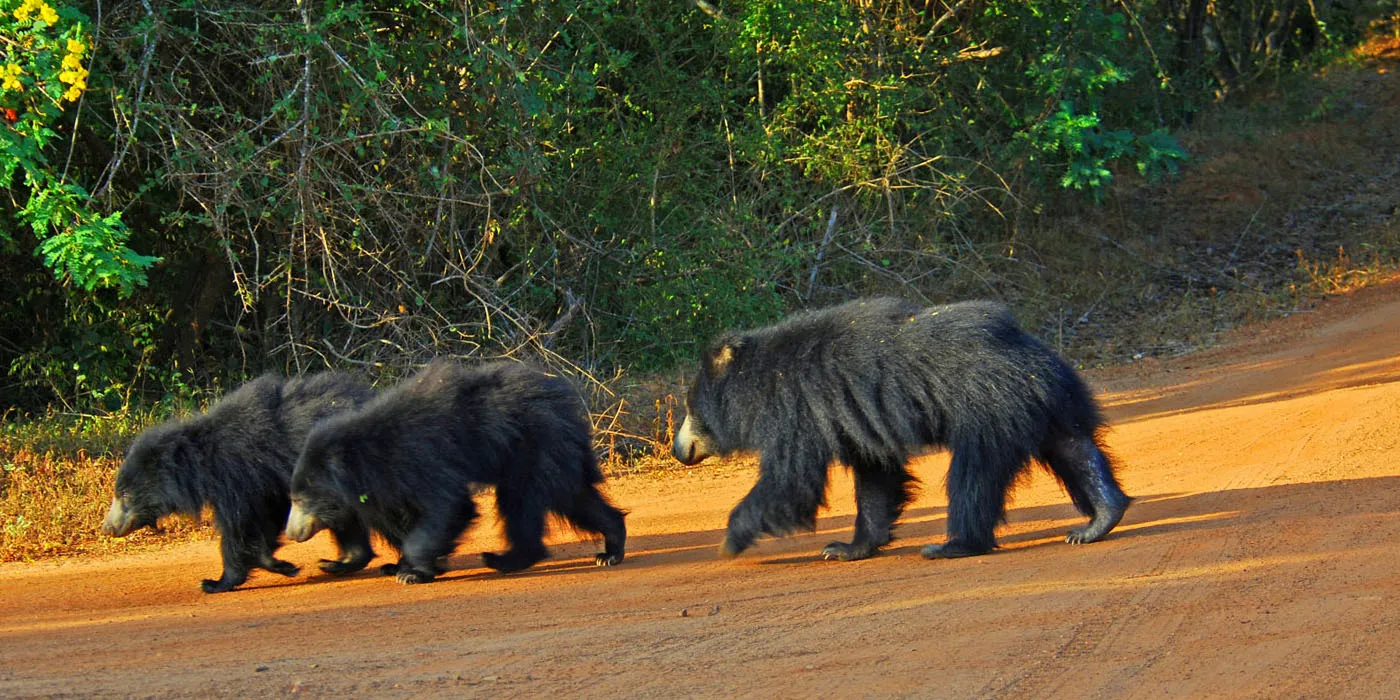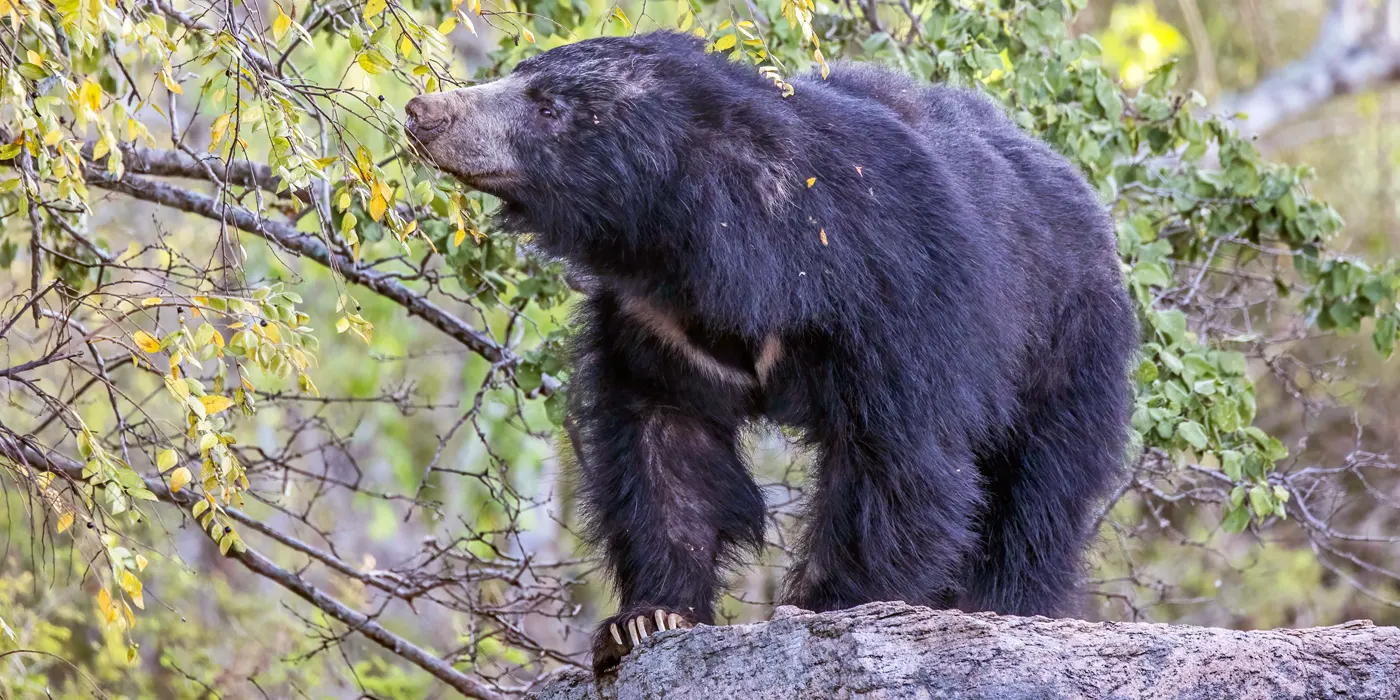
The Sri Lankan sloth bear, known scientifically as “Melursus ursinus inornatus”, is an extraordinary and captivating creature that can be found in the forests of Sri Lanka. This bear has get attention from wildlife lovers and researchers alike due to its unique appearance, fascinating behavior, and conservation significance.
Appearance and Habitat
The Sri Lankan sloth bear is a medium size mammal with distinct physical features. They have stocky with a long and extremely shaggy black coat and a V or Y shaped marking on the chest. These bears possess long, curved claws that enable them to skillfully climb trees, reaching impressive heights of up to 6 feet when standing on their hind legs. Body grows up to 6 feet in length, and can weigh up to 140kg for a male and 95 kg for a female.
Diet and Feeding Habits
Being omnivorous, the Sri Lankan sloth bear has a diverse diet consisting of both plant matter and meat. Their food preferences vary depending on the season and food availability. They eat in a wide range of delicacies, including fruits, insects, termites, honey, and small animals.
One of the unique feeding behaviors of these bears is their ability to extract honey from beehives. With their sharp claws, they deftly open beehives and savor the sweet honey and bee larvae inside. This adaptive behavior showcases their resourcefulness in finding food sources.
Behavior and Lifestyle
Sloth bears in Sri Lanka are known for their solitary nature. They are most active during the early morning and late evening hours, seeking rest and sleep during the hottest parts of the day. Their movement is slow and deliberate, often hanging from tree branches and relying on their strong claws for support.
While generally peaceful, sloth bears can display aggression if they feel threatened or cornered. In such situations, they may stand on their hind legs, revealing their formidable claws as a warning sign.

Conservation Status
The Sri Lankan sloth bear is classified as a vulnerable species on the International Union for Conservation of Nature (IUCN) Red List. Several factors pose threats to their survival, including habitat loss due to deforestation and human encroachment, poaching for body parts and traditional medicine, as well as conflicts between humans and bears.
Threats and Conservation Efforts
Efforts are underway to address the conservation concerns surrounding the Sri Lankan sloth bear. Measures include the establishment of national parks and protected areas to safeguard their natural habitat. Conservation organizations are implementing community-based programs to reduce human-bear conflicts and promote sustainable living practices.
Educational campaigns are raising awareness about the importance of protecting these bears and their habitat. Research and monitoring projects aim to gather valuable information about their population size, behavior, and ecological requirements.
Interaction with Humans
Sri Lankan sloth bears have a rich history of interaction with humans in the country. Folklore and mythology often depict them as mystical creatures. However, increased habitat destruction and human encroachment have led to more frequent encounters and conflicts between bears and humans.
It is vital for local communities and authorities to promote responsible tourism and educate the public on appropriate behavior when encountering wildlife. By maintaining a safe distance and showing respect for their natural habitat, humans can peacefully coexist with these magnificent creatures.
Where to See Sri Lankan Sloth Bear

For those eager to witness the beauty of Sri Lankan sloth bears in the wild, we recommend the following locations:
Wilpattu National Park
Situated in the dry zone of Sri Lanka, Wilpattu offers a captivating wildlife experience. Embark on a thrilling jeep safari through the park to spot the elusive sloth bears amidst the diverse flora and fauna.
Yala National Park
As one of Sri Lanka’s renowned national parks, Yala is a paradise for wildlife enthusiasts. Explore the park on an exciting jeep safari and keep a keen eye out for the fascinating Sri Lankan sloth bears that call this biodiverse ecosystem their home.
Udawalawe National Park
Located in the southern part of Sri Lanka, Udawalawe National Park is another excellent destination to observe sloth bears in their natural habitat. Plan a visit to this park and encounter these magnificent creatures alongside other fascinating wildlife species.
Please note that sightings of sloth bears in the wild can never be guaranteed as they are elusive animals. It is recommended to visit these national parks with a knowledgeable guide who can enhance your chances of spotting these incredible creatures.
By visiting these locations, you can increase your chances of experiencing the beauty and wonder of Sri Lankan sloth bears in their natural environment. Each day spent in their presence promises to be filled with awe-inspiring moments, unforgettable encounters, and memories that will last a lifetime. Let us help you create an itinerary tailored to your preferences, ensuring a truly remarkable experience on this enchanting island.
FAQs about Sri Lankan Sloth Bear
1. What is a Sri Lankan sloth bear?
A Sri Lankan sloth bear is a subspecies of sloth bear found primarily in Sri Lanka. It is known for its shaggy black coat and unique behaviors.
2. How does the Sri Lankan sloth bear differ from other sloth bear subspecies?
The Sri Lankan sloth bear has a distinctively shaggier and darker coat than other sloth bear subspecies. It also has a longer, more flexible tongue, which it uses to extract insects from nests and tree bark.
3. What is the habitat of the Sri Lankan bear?
The Sri Lankan sloth bear is found in the dry lowland forests and scrublands of Sri Lanka. It prefers areas with dense vegetation and rocky outcrops for shelter.
4. What do Sri Lankan sloth bears eat?
Sri Lankan sloth bears are omnivorous, but they primarily eat insects, especially termites and ants. They also eat fruits, nuts, honey, and small animals.
5. Are Sri Lankan sloth bears endangered?
Yes, the Sri Lankan sloth bear is considered vulnerable to extinction. The main threats to its population are habitat loss, poaching, and human-bear conflict.
6. How do Sri Lankan sloth bears reproduce?
They typically have a gestation period of around 6 to 7 months. Females give birth to one to two cubs at a time. Cubs are born blind and helpless and remain dependent on their mother for about a year.
7. Are sloth bears aggressive towards humans?
Sri Lankan sloth bears are generally shy and avoid humans. However, they can become aggressive if they are threatened or cornered. It is important to give these bears a wide berth and avoid any contact with them.
8. What conservation efforts are in place to protect Sri Lankan sloth bears?
There are a number of conservation efforts in place to protect the Sri Lankan sloth bear. These include: Protecting their habitat, Combating poaching, Mitigating human-bear conflict and Raising awareness about the plight of the Sri Lankan sloth bear.
9. Can I see Sri Lankan sloth bears in the wild as a tourist?
There are a few national parks and wildlife reserves in Sri Lanka where you may have a chance to see Sri Lankan sloth bears. These include: Yala National Park, Wilpattu National Park, Udawalawe National Park. However, sightings are relatively rare, so it is important to be patient and have a good guide.
10. Are there any unique cultural or mythological associations with Sri Lankan sloth bears?
Yes, the Sri Lankan bear has a number of cultural and mythological associations in Sri Lanka. It is often associated with deities and has symbolic significance. For example, the sloth bear is considered to be a symbol of strength and power in some traditional stories and rituals.
